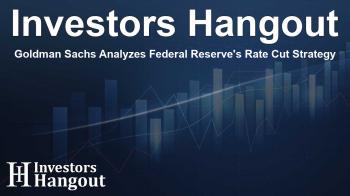Goldman Sachs Analyzes Federal Reserve's Rate Cut Strategy

Understanding the Federal Reserve's Approach to Rate Cuts
Recently, the Federal Reserve released minutes from their latest meeting that revealed their intention to proceed with a slower pace of interest rate cuts, as highlighted by analysts at Goldman Sachs. This cautious approach stems from evolving economic conditions and uncertainty in policy directions.
Impact of Political Changes on Inflation
Recent political developments have contributed to a sense of uncertainty among Federal Reserve staff regarding the inflation outlook. The minutes from the December gathering of the central bank indicated that policymakers are grappling with potential impacts from proposed tariffs and immigration policies.
Concerns were raised that these changes could disrupt current trends in price gains, leading to speculation that the journey toward the Fed's inflation target of 2% may take longer than initially expected.
Policymakers' Concerns and Inflation Risks
Goldman Sachs analysts noted that officials expressed cautious optimism about the progress being made regarding inflation. However, they emphasized ongoing risks that could disrupt this progress. The balancing act for the Federal Open Market Committee has become increasingly challenging, especially after a substantial interest rate cut of one percentage point in the previous year.
As the Fed navigates its decisions, there seems to be a collective agreement on maintaining a vigilant stance, especially with the ongoing discussions about further cuts. The minutes suggested that some members prefer a careful approach to any additional reductions this year.
Market Reactions and Future Expectations
Following the release of these minutes, market expectations shifted, with many now believing the Fed might keep borrowing costs stable at upcoming meetings. This has led to forecasts predicting that any further rate cuts will not occur until at least the middle of the year.
Attention is currently directed toward the monthly employment report, which holds significant importance in shaping the Fed’s strategies. Data released recently indicated a slowdown in private payrolls while showing a decline in jobless claims, creating a mixed economic picture.
The Potential Halt in Balance Sheet Reduction
In a note to clients, Goldman Sachs analysts conveyed that discussions regarding the Fed's balance sheet reduction were notably absent in the meeting minutes. Some experts have speculated that the central bank may take a pause from its quantitative tightening efforts as early as 2025.
The analysts pointed out that the absence of detailed conversation from Fed officials regarding this topic leaves much open to interpretation. Given the current availability of reserves and decreasing funding pressures, the timeline for any adjustments to the quantitative tightening strategy will likely shift.
Upcoming Economic Strategies and Insights
Goldman Sachs now anticipates that the Treasury runoff, which pertains to the reduction of securities held by the Fed, will continue through to the end of March. Initially projected for January, this adjustment reflects changing conditions. They also believe that the runoff of mortgage-backed securities is set to conclude by the end of June.
Frequently Asked Questions
What do the Fed minutes indicate about future rate cuts?
The minutes suggest a slower pace of interest rate cuts, reflecting the Fed’s careful approach influenced by current economic conditions.
How does political change influence inflation outlook?
Political developments have created uncertainty, particularly regarding proposed tariffs and immigration policies that could affect price trends.
What are market expectations following the Fed meeting?
Market sentiment has shifted, with many anticipating that the Fed will keep borrowing costs stable at upcoming meetings until later this year.
Is the Fed planning to halt its balance sheet reduction?
Analysts have noted a lack of discussion regarding balance sheet reduction, suggesting potential pauses in quantitative tightening efforts.
What changes are expected in Treasury runoff?
Goldman Sachs predicts Treasury runoff will now continue until the end of March, reflecting a revised outlook on monetary policy changes.
About Investors Hangout
Investors Hangout is a leading online stock forum for financial discussion and learning, offering a wide range of free tools and resources. It draws in traders of all levels, who exchange market knowledge, investigate trading tactics, and keep an eye on industry developments in real time. Featuring financial articles, stock message boards, quotes, charts, company profiles, and live news updates. Through cooperative learning and a wealth of informational resources, it helps users from novices creating their first portfolios to experts honing their techniques. Join Investors Hangout today: https://investorshangout.com/
Disclaimer: The content of this article is solely for general informational purposes only; it does not represent legal, financial, or investment advice. Investors Hangout does not offer financial advice; the author is not a licensed financial advisor. Consult a qualified advisor before making any financial or investment decisions based on this article. The author's interpretation of publicly available data presented here; as a result, they should not be taken as advice to purchase, sell, or hold any securities mentioned or any other investments. If any of the material offered here is inaccurate, please contact us for corrections.
